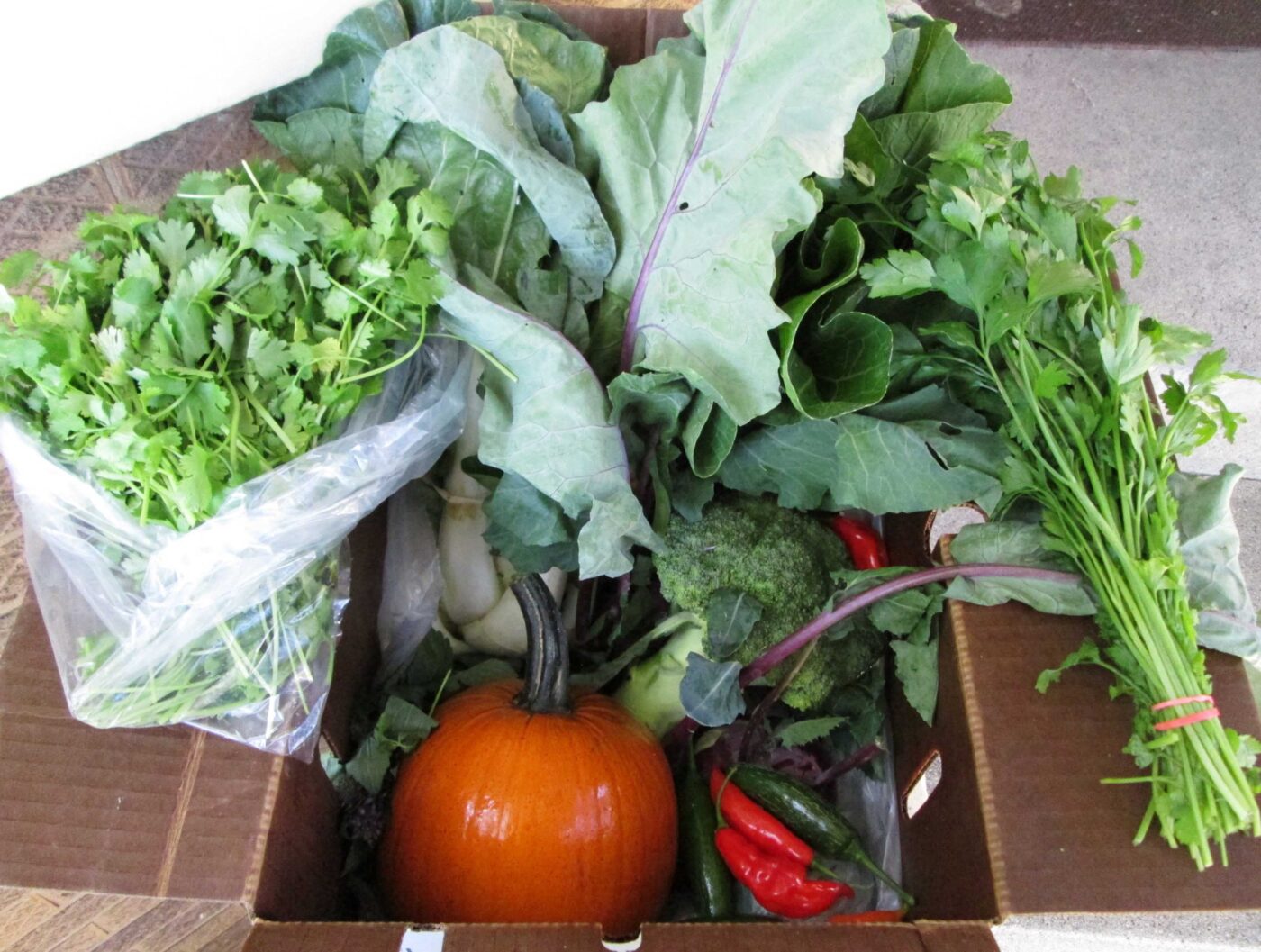
My Experience
An organic farmer once told me his land is truly alive—moist, rich with clumps and teeming with worms—in contrast to the lifeless dust found on many conventional farms. I joined his and a number of other Community Supported Agriculture (CSA) groups over the years. With CSAs, you commit to purchase a box of a variety of different vegetables through the summer and fall months. This often requires learning about new foods – but I welcome that, since you get to expand your vegetable diet, and try new online recipes. Another way to have your food money go directly to the farmer is with Farmers Markets.
Your Choices
| Action Choices and Links |
| Purchase Organic Fruits and Vegetables |
| Support Farmers Directly through Farmers Market or Community Supported Agriculture |
Purchase Organic Fruits and Vegetables
Conventional farming practices often harm soil microorganisms through excessive use of fertilizers, pesticides, herbicides, and fungicides. However, there is now a growing emphasis on avoiding over-fertilization by using precise, prescriptive methods. Soil erosion remains a significant concern because unhealthy soils are prone to being washed or blown away by rain and wind.
Organic foods offer health benefits by providing higher levels of micronutrients and lower concentrations of herbicides and pesticides. The Environmental Working Group (2024) publishes the Dirty Dozen™ list, highlighting foods with the highest pesticide residues. This list includes leafy greens, berries (such as cherries), peppers, green beans, and fruits like apples, pears, peaches, and nectarines. Conversely, their Clean Fifteen features produce with minimal pesticide exposure, including fruits with protective rinds—honeydew, watermelon, papaya, mango, kiwi, avocado, and pineapple—or root vegetables like carrots, sweet potatoes, and onions, as well as mushrooms, asparagus, sweet peas, cabbage, and sweet corn. For detailed information and the full list, visit: https://www.ewg.org/foodnews/dirty-dozen.php.
Almost all organic plant products analyzed produce lower greenhouse gas emissions per acre compared to conventional farming. However, conventional methods typically achieve higher yields, or products per acre (Chiriaco, 2022). Using statistical medians, organic farming emits 43% less greenhouse gases (GHG) per acre, but only 12% less GHG per product. When evaluating GHG emissions per product, organic farming generally outperforms conventional methods for most vegetables and fruits. Conventional farming tends to outperform organic for most grains, especially rice, while livestock emissions vary by product, with both methods performing similarly overall. Legumes are a notable exception, where conventional farming produces lower GHG emissions both per acre and per product. The science is still evolving; some data come from single studies, and further improvements are expected as understanding of organic farming practices advances.
Farmers are increasingly encouraged to adopt regenerative farming, which incorporates many of the techniques used by organic farmers but without the strict regulations and certification requirements. These methods are believed to combat climate change by enhancing soil carbon sequestration and improving resilience against the intensifying storms that contribute to land erosion. For more information, see Why Organic is Helpful: The Science below.
Support Farmers Directly through Farmers Market or Community Supported Agriculture
Quality organic products can often be found at local grocery stores, farmers’ markets, food cooperatives, and through community supported agriculture (CSA) programs. Purchasing from a farmer’s market or CSA can support farmers directly, giving them a living wage.
Community Supported Agriculture: One effective way to reduce food transportation and support organic farming is by joining a CSA (Community Supported Agriculture). With a CSA membership, you receive fresh food every week or every two weeks, typically paid for in advance. Many CSAs offer multiple pickup locations, and some provide home delivery. Additionally, CSAs are increasingly allowing members to customize the contents of their boxes. As shown in the picture below, the quality of the food is outstanding!

CSAs are typically regionally local, which reduces food transportation and supports sustainability. More importantly, their organic farming methods avoid artificial pesticides, herbicides, and petroleum-based fertilizers. Healthy soil enriched with organic matter sequesters carbon, helping to remove it from the atmosphere. This living soil retains water more effectively, making it drought-resistant. The produce is healthier, with fewer chemical residues and often higher nutrient levels. Many people also find that organic foods have a superior taste. Additionally, CSAs provide a great opportunity to try new and unfamiliar fruits and vegetables.
Some CSAs offer an optional fruit share. Our fruit share options are listed below.

References
Environmental Working Group (2024) EWG’s shopper’s guide: The Dirty Dozen™. From: https://www.ewg.org/foodnews/dirty-dozen.php.
FAO and ITPS. (2015). Status of the World’s Soil Resources (SWSR) – Main Report. Food and Agriculture Organization of the United Nations and Intergovernmental Technical Panel on Soils, Rome, Italy.
Wedderburn-Bisshop, Gerard (2024) Consistent, Inclusive Emissions Accounting Identifies Agriculture as the Leading Cause of Climate Change.
Michael Clark and David Tilman (2017) Comparative analysis of environmental impacts of agricultural production systems, agricultural input efficiency, and food choice. Environ. Res. Lett. 12 (2017) 064016, IOP Publishing.
Maria Vincenza Chiriaco, Simona Castaldi, Riccardo Valentini (2022) Determining organic versus conventional food emissions to foster the transition to sustainable food systems and diets: Insights from a systematic review. Journal of Cleaner Production 380 (2022) 134937, Elsevier Ltd.
Smith P, Bustamente H, Ahammad H., Clark H., Dong EA. (2014) Agriculture, Forestry and Other Land Use (AFOLU). In Climate Change 2014: Mitigation of Climate Change. Contribution of Working Group III to the Fifth Assessment Report of the International P Climate Change, Cambridge University Press, Cambridge UK and New York NY.
